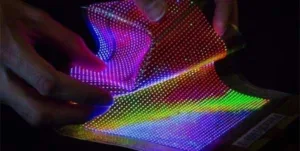MIcroLED displays are often seen as the future challenger of OLED displays, with the emphasis on ‘future’. Many start up companies and technology developers are working on the issues surrounding these alternative LED displays based on discrete semiconductor emitters. In contrast to OLED where chemistry, cost effective manufacturing, and lifetime is the name of the game, microLED displays are using semiconductor emitters that are already being manufactured in the billions and develop new ways of packaging them directly on a backplane without packaging them individually.
PlayNitride was one of these companies that was rumored to be on the short list of Samsung acquisition target companies. However this move never materialized. Now BusinessKorea has published an article “Mass Production of Micro LED Panels for Mobile to Be Tried in H2 This Year” on September 13th, where they hint at first mass production trials by exactly this company. Play Nitride can also be found under the name “Evolution”, a play on their technology of UV-based encapsulation of LEDs. Indeed their current products are all pretty heavy air cooled devices that provide high irradiance light sources.
PlayNitride microLED Display, Credit BusinessKorea
The article in BusinessKorea instead focuses on the manufacturing of 5″ microLED displays for smartphones and claims that this will happen in the second half of 2017. In practical terms this means in the next three months. The most interesting part of the article is where the details of the current status of PlayNitride are discussed . According too the paper’s sources, PlayNitride is using chips with a side length of 100 micrometers, which they can place with an efficiency of 99%. It takes them 10 seconds to transfer and place 200,000 LEDS to a panel. This is pretty impressive but reminds of the early LCD panels manufacturing where pixel errors were a common and acceptable defect.
They also admit that at the current point making such a 5″ display costs about $300 compared to $70- $80 for a comparable OLED. This is a factor of 4, but it is still impressive how quickly they have come this close to a OLED display manufactured on a line that cost many billions in R&D money to achieve this level. Maybe microLED is indeed a viable solution for some mobile and even large area displays? NH
Analyst Comment
Of course, 99% of a 2560 x 1440 would mean around 100K dead sub pixels! Getting from 99% to 99.99999% or so is one of the real challenges for MicroOLED. (BR)

